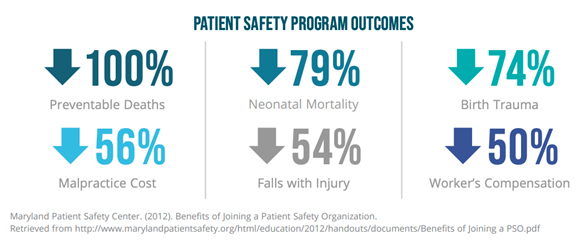2 min read
The Impact of Patient Safety and Quality of Care Programs
Performance Health Partners
November 7, 2019
We are currently witnessing the modernization of patient safety, clinical quality, and outcomes management in healthcare. And yet, the majority of the more than 890,000 healthcare facilities in the United States (1)– especially small to mid-sized providers – have not yet implemented technology to manage and monitor outcomes in patient safety and quality.
They accomplish this by:
- Tracking, reporting, and analyzing reported incidents that have already occurred.
- Leveraging both event data and best practices to continuously improve care delivery processes to reduce and prevent errors from occurring in the first place. (2)
These programs have proven to be instrumental in not only improving patient safety and quality of care but also reducing costs borne by the entire healthcare system. A 5-year Ascension study published in Modern Healthcare found that implementing patient safety programs resulted in (3):

Improving Outcomes with Patient Safety Technology
Healthcare incident reporting software is a critical component of efforts to improve patient safety and quality of care, efficiency and reduce health disparities across healthcare organizations by allowing them to track and learn from patient safety incidents. An incident is an event or circumstance that could have resulted — or did result — in harm to a patient. (4)
Even “near misses” or "good catch", or events that did not result in patient harm (but could have), provide opportunities for proactive learning and improvement. When healthcare organizations rely upon manual patient safety tracking, they risk inconsistent or incomplete data entry and lack the tools for effectively synthesizing event data for the purposes of learning, training, prompt remediation, and prevention.
Further, without an incident reporting system serving as a central channel for team communication, real-time event information or status changes related to patient safety activities is not instantly available.
An incident reporting system can solve data collection issues. It facilitates incident data aggregation and analysis so that providers can perform root cause analysis, identify patient safety trends, and determine ways to reduce and prevent further harm; and it improves care coordination between and across providers.
Standardizing data also allows providers to submit information to a PSO for external review, continuing education, and participation in efforts to improve patient outcomes and population health.
Conclusion
With the right incident reporting software, it's possible for healthcare organizations to improve patient safety and quality of care by decreasing medical errors, reducing patient risk, and improving overall patient safety — more efficiently than ever before.
Is your healthcare organization looking to reduce incidents and improve outcomes with a technology solution?
Click below to download our Incident Reporting System guide and see what you should be looking for in an effective incident reporting software:
References:
1- North American Industry Classification System (NAICS) Downloadable Files. (2012, May 15). Retrieved from https://www.census.gov/eos/www/naics/downloadables/downloadables.html
2- Good Samaritan Hospital. (n.d.). Our Patient Safety Program. Retrieved from https://www.goodsam.org/About-Us/Patient-Safety-Program.aspx
3- Maryland Patient Safety Center. (2012). Benefits of Joining a Patient Safety Organization. Retrieved from http://www.marylandpatientsafety.org/html/education/2012/handouts/documents/Benefits of Joining a PSO.pdf
4- Clinical Excellence Commission. (2009). What is a patient safety incident? Retrieved from http://www.cec.health.nsw.gov.au/__data/assets/pdf_file/0018/259011/ what_is_a_patient_safety_incident.pdf


